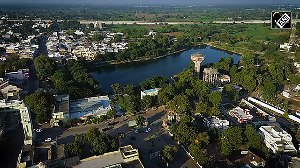India is in its 60th year of independence. Yet the poor continue to be poor, the rich continue to get richer and in between is the perishing Indian middle class. Islands of wealth and prosperity are surrounded by a sea of poverty. It is a grim battle, and the middle class is slowly losing its grip.
In a growing economy, the middle class has to be big enough to consume what is produced. But they are burdened by taxes and sometimes squeezed by choice.
The media has created this urge to 'have it all & have it your way.'
In the coming days only the ones who have a better control over their needs will survive; like those avoiding the 'want' for the latest Plasma TV, the latest iPods and iPhones, and foreign tours year after year. We have to be like the Capitalists controlling Capital rather than be their labourers.
The sheer bounty of the gadgets that we really do not need has become indispensable.
As long as people believe status is the most important thing and are willing to pay any price to display a certain status, there is trouble brewing for the middle class. Majority of the professional middle class is now part of the Diaspora.
Everything in India has happened despite the system. However, the system needs a complete overhaul -- into one of strict meritocracy -- and until that happens India will continue to play second fiddle to China. Is it because it is a benchmark against Pakistan and being happy about its progress or is it because we already assume that China is beyond reach?
Taking corrective action
First and foremost, we need to tackle corruption. Corruption is rampant and not confined anymore to the politicians and the bureaucrats. The world has always branded India as one of the most corrupt countries and unfortunately it does not affect anybody in India as long as it works in one way or the other.
Most medicines, including life-saving drugs, are spurious, milk is hormone-induced, mangoes are injected with carbides, and buildings are made of cheap materials. There are always a hidden costs -- be it a personal loan, holiday trip, insurance or a home loan.
When your bank says there is no pre-payment cost, you need not be overjoyed. Try pre-paying your loan and you will soon realize you can't pay more than a certain sum a year. The bank after all raises deposits at a rate and may be it helps the bank in mitigating these costs. But shouldn't they clearly specify upfront as to how much a consumer can pre-pay in the subsequent years.
Mortgage market is in turmoil everywhere and government should clamp down on lending abuses by the banks. Penalties for early repayment are surely unjustified.
The Communist Party of India has a different theory on corruption. According to them, people hate corruption as long as they are not part of it. They have been ruling West Bengal for 30 years, democratizing corruption by letting a large number of people benefit from it.
It is high time we amend the Indian Police Act of 1861, which is more suited to the colonial style of ruling. This act was more designed to serve the interest of colonial administration and the government seems to be enjoying it. It has in-built provisions for delays, prolonged litigations and evasion... which is what is happening today.
Nuisance factor is the highest among the police. With conviction rate less than 10 per cent in our criminal courts, corruption is a high-profit business. Even if somebody wants to take on the system, the risks in terms of loss of profit are much more than the gain. This Act needs to be modified to facilitate the maintenance of law and order by police without giving any license to violate human rights.
The biggest cause of corruption in today's India is undoubtedly the political patronage given to it. The nexus between the corrupt politicians, bureaucrats and builders have been clearly proved in recent years. Another reason could be that in India, making money fast is often admired.
A government employee feels he should earn enough not just for himself and his lifetime but also for his children, grand children and perhaps for the generations to come. This is probably the basic motivation to amass public wealth. We are also laid back in nature and try to find immediate solutions when faced with a problem... so corruption thrives.
We are selfish, greedy and lazy and wish to get things done at any cost.
Is consumer really the king?
Then comes consumerism and as it spreads, in some ways, the environment, health and happiness suffer. Desire has overtaken need. Desire for bigger cars and bigger houses lead to higher levels of debt and lifestyles, leading to accumulation of mostly non-essential goods.
Banks and credit card companies will do anything to extract the money from customers.
Luxuries are converted to necessities by those smart marketing agents. The merchants these days do not have a liking for debit card holders and always offers benefits to credit card holders.
They target low income people with low credit ratings so that the original amount has been paid several times over. They encourage customers to borrow more and stretch out the repayment. They also reserve the right to change the terms at any time without any reason.
So, more consumerism leads to increased debts, which leads to longer working hours to pay for that extravagant life style at the cost of lesser time with family and friends. How often do we fall prey to this despite knowing everything?
The march of the migrants
Mumbai and Kolkata continue to look down upon migrant labourers from Bihar and Eastern Uttar Pradesh, but what about the millions of migrants coming from across the border.
They may not have a passport in their own country, but definitely have more than one here. Influx of Bangladeshis has created problems... initially in Assam but now spreading to Tripura, Nagaland and West Bengal.
It is no longer Assam or Tripura's problem alone, but one that must concern everyone in India. At this rate, very soon Arunachal Pradesh will become another Tibet.
On one side we have massive migration and on the other side infiltration. Between the year 1997 and 1998 a financial crisis swept like a forest fire through the then "tiger economies" of Southeast Asia.
These countries (Thailand, Malaysia, Singapore, Indonesia, Hong Kong and South Korea) registered some of the most impressive economic growth rates in the world. However, it came to an abrupt end in the beginning of 1998 when in one country after another, stock markets and currency markets imploded.
Fact-finding showed that stock markets in many of these countries had lost 75 per cent of their value and currencies had depreciated against the US dollar by a similar amount. The wealth created by export helped to fuel investment boom in commercial and residential property.
All too often, the investments were made on the basis of projections about future demand conditions that were unrealistic. The result was the emergence of significant excess capacity. Southeast Asia was in the grip of investment boom and much of it was financed with borrowed money.
To make matters worse, most of the borrowing to fund these investments had been in US dollars as opposed to local currencies and the region's local currencies were pegged to the dollars. The governments were in a quandary to maintain the dollar peg. So the bait was perfectly laid by the West and when the markets crashed (except Singapore, whose economy was probably the most stable in that region), the IMF like the police in a Bollywood movie came as planned into the party. IMF loans have always come with strings attached.
These analogies may sound stretched, but Indian stocks seems to be treading exactly on similar territory and the bust seems to be just round the corner. Till such time, India will remain to be a great investment story.
Properties are selling at a price never seen before... far outstripping affordability. By comparison, Indian stocks are relatively expensive then their western counterparts. For example, Toyota spends so much on research, innovation and hybrid models. Their hydrogen fuel cell-powered vehicles could hit the showrooms by 2015 and still you will find the appreciation of an Indian carmaker's stock prices much more.
The rise is exceptionally high and it must be viewed with extreme caution and best bought after substantial corrections. After 60 years, the challenges still remain the same -- poverty, hunger, lack of education, exploitation.
In rural India we have a lot to catch up with land reforms and tenancy reforms. From casting of votes we have come to a stage of voting for a caste. So far, the wealth is concentrated with a very small segment of the population. So, life begins at 60 is coming true for India.
As Oscar Wilde rightly said: Every saint has a past and every sinner has a future. So let us forget our past and start working towards a future.
Ujjal Bhattacharya is a IT systems and database architect working in Kuwait





